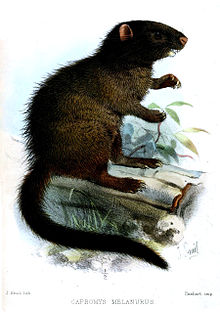Black-tailed hutia
Appearance
(Redirected from Mysateles melanurus)
| Black-tailed hutia | |
|---|---|

| |
| Scientific classification | |
| Domain: | Eukaryota |
| Kingdom: | Animalia |
| Phylum: | Chordata |
| Class: | Mammalia |
| Order: | Rodentia |
| Family: | Echimyidae |
| Tribe: | Capromyini |
| Genus: | Mesocapromys |
| Species: | M. melanurus
|
| Binomial name | |
| Mesocapromys melanurus (Poey, 1865)
| |
| Synonyms | |
| |
The black-tailed hutia (Mesocapromys melanurus), also known as the bushy-tailed hutia, is a small, furry, rat-like mammal found only in Cuba. It lives in lowland moist forests and is threatened by habitat loss.[2] It is a member of the hutia subfamily (Capromyinae), a group of rodents native to the Caribbean that are mostly endangered or extinct.
Although it was formerly classified in the genus Mysateles, phylogenetic evidence supports it belonging to the genus Mesocapromys.[3]
References
[edit]- ^ Kennerley, R.; Young, R.; Turvey, S.T. & Borotto-Páez, R. (2018). "Mysateles melanurus". IUCN Red List of Threatened Species. 2018: e.T14256A22187606. doi:10.2305/IUCN.UK.2018-1.RLTS.T14256A22187606.en. Retrieved 11 November 2022.
- ^ "Mesocapromys melanurus (Poey, 1865)". ASM Mammal Diversity Database. American Society of Mammalogists. Retrieved 2021-10-02.
- ^ Fabre, Pierre-Henri; Upham, Nathan S.; Emmons, Louise H.; Justy, Fabienne; Leite, Yuri L. R.; Loss, Ana Carolina; Orlando, Ludovic; Tilak, Marie-Ka; Patterson, Bruce D.; Douzery, Emmanuel J. P. (2016-12-25). "Mitogenomic phylogeny, diversification, and biogeography of South American spiny rats". Molecular Biology and Evolution: msw261. doi:10.1093/molbev/msw261. ISSN 0737-4038.
- Woods, C.A.; Kilpatrick, C.W. (2005). "Infraorder Hystricognathi". In Wilson, D.E.; Reeder, D.M (eds.). Mammal Species of the World: A Taxonomic and Geographic Reference (3rd ed.). Johns Hopkins University Press. pp. 1538–1600. ISBN 978-0-8018-8221-0. OCLC 62265494.

